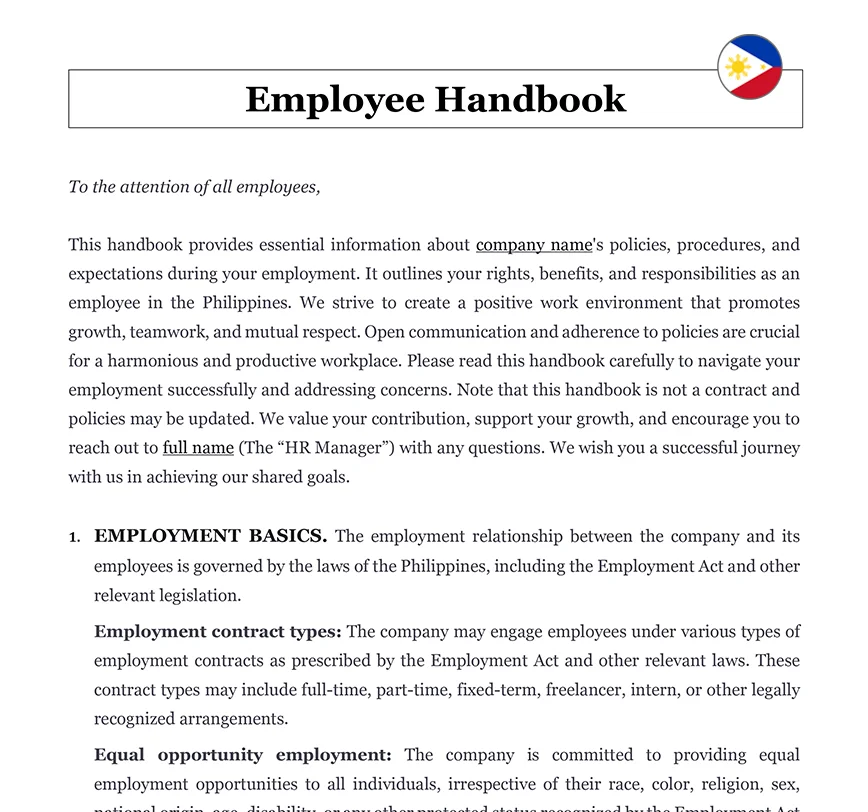Ready to use legal template
Drafted by experienced lawyers
Compliant with Filipino law
Ready to use legal template
Drafted by lawyers
Compliant with Filipino law
Learn more about Employee Handbook in Philippines
An Employee Handbook is an essential document that outlines a company’s policies, procedures, and expectations for employee behavior in the workplace. It serves as a reference guide for both employers and employees, covering topics such as working hours, leave entitlements, code of conduct, disciplinary actions, and benefits. In the Philippines, having a well-structured Employee Handbook is crucial for promoting transparency, ensuring compliance with labor laws under the Department of Labor and Employment (DOLE), and protecting both parties in the event of disputes. It also helps foster a consistent and professional work environment. Download our Employee Handbook available in an easy to edit Word format and drafted by expert to be used in the Philippines.
Table of contents
-
What is an Employee Handbook?
-
Why is it important to have an Employee Handbook?
-
What does an Employee Handbook include?
-
What are the legal requirements when making an Employee Handbook?
-
How can you create an Employee Handbook tailored for Philippines?
-
What are the policies and procedures in the Philippines?
-
How can you effectively communicate your company culture and values?
What is an Employee Handbook?
An Employee Handbook is a comprehensive document that outlines the policies, procedures, expectations, and guidelines of a company. It serves as a valuable resource for employees, providing them with important information about the organization’s culture, values, and rules. The Employee Handbook covers various aspects of employment, such as working hours, leave policies, code of conduct, benefits, and disciplinary procedures.
Why is it important to have an Employee Handbook?
Having an Employee Handbook is essential for several reasons. Firstly, it ensures consistency and fairness in the application of company policies. It helps employees understand what is expected of them and provides guidelines for their behavior and performance. Secondly, the Employee Handbook helps protect the rights of both the company and the employees. It outlines the legal obligations of the employer and the rights and responsibilities of the employees, promoting a transparent and compliant work environment.
What does an Employee Handbook include?
An effective Employee Handbook serves as a comprehensive guide for employees, providing them with essential information about company policies, procedures, and expectations. Here are key components that make your document effective:
1. Introduction and Welcome Message: Begin the Employee Handbook with a warm and engaging introduction that conveys the company’s mission, values, and culture. A welcome message from top management or the CEO sets a positive tone and emphasizes the company’s commitment to its employees.
2. Employment Policies: Clearly outline the company’s employment policies, including information on employment status, equal opportunity, anti-discrimination, harassment prevention, and code of conduct. Provide guidelines for expected employee behavior, dress code, attendance, and punctuality.
3. Job Responsibilities and Expectations: Clearly define job roles, responsibilities, and performance expectations. Outline the general work hours, attendance requirements, and rules regarding breaks and meal periods. Specify any specific job-related policies or procedures relevant to your industry.
4. Compensation and Benefits: Provide a comprehensive overview of the company’s compensation structure, including salary, bonuses, incentives, and benefits such as healthcare, retirement plans, and vacation leave. Explain the process for payroll, salary reviews, and benefits enrollment.
5. Leave and Time-Off Policies: Detail the company’s policies on various types of leaves, including vacation leave, sick leave, family and medical leave, and other forms of time-off. Specify the procedures for requesting and approving leaves, as well as any documentation required.
6. Performance Evaluation and Development: Explain the company’s performance evaluation process, including how goals are set, performance reviews are conducted, and feedback is given. Outline opportunities for employee development, training programs, and career advancement. Themis partner also provides a Employee Performance Evaluation to help you manage your workforce results.
7. Workplace Health and Safety: Emphasize the importance of workplace safety and provide guidelines on maintaining a safe and healthy work environment. Include policies on accident reporting, emergency procedures, and employee responsibility in ensuring safety.
8. Communication and Technology Usage: Specify guidelines on communication channels, use of company-provided technology and equipment, internet and email usage, and social media policies. Address expectations regarding professional conduct and confidentiality in the digital sphere.
9. Grievance and Conflict Resolution: Outline the procedures for addressing grievances, complaints, and conflict resolution within the organization. Provide employees with information on how to report concerns, the steps involved in addressing issues, and the assurance of a fair and confidential process.
10. Acknowledgment and Signature: Require employees to acknowledge that they have received, read, and understood the Employee Handbook by signing an acknowledgment form. This helps to ensure that employees are aware of the policies and procedures outlined.
What are the legal requirements when making an Employee Handbook?
When creating an Employee Handbook in the Philippines, it is crucial to consider the legal requirements to ensure compliance with local labor laws and regulations. Here are some key legal requirements that should be taken into account:
1. Labor Code Compliance
The Philippine Labor Code serves as the primary legislation governing employment relationships. Ensure that your Employee Handbook aligns with the provisions of the Labor Code, including regulations on minimum wage, working hours, overtime, leaves of absence, termination procedures, and employee benefits.
2. Anti-Discrimination Laws
The Philippines has laws in place to protect employees from discrimination based on gender, age, religion, disability, and other protected characteristics. Include policies in your Handbook that promote equal employment opportunities and prohibit any form of discrimination or harassment in the workplace.
3. Occupational Safety and Health Standards
Compliance with occupational safety and health standards is essential to ensure a safe working environment. Familiarize yourself with the requirements set by the Occupational Safety and Health Standards and incorporate relevant policies in the Handbook, such as procedures for reporting accidents, safety guidelines, and emergency protocols.
4. Privacy and Data Protection
The Data Privacy Act of 2012 governs the collection, use, and processing of personal information. Ensure that your Handbook includes policies on data privacy, confidentiality, and employee consent when handling personal data in compliance with the law.
5. Employee Benefits and Leaves
The Philippines has specific regulations regarding employee benefits, such as holiday pay, service incentive leave, maternity leave, paternity leave, and other forms of statutory benefits. Include these provisions in your Handbook to inform employees of their entitlements and the procedures for availing them.
6. Termination Procedures
Clearly outline the procedures for termination, including grounds for termination, notice periods, and the process for conducting disciplinary actions or investigations. Adhere to the legal requirements for due process and procedural fairness during termination.
ℹ️ Themis Partner helps you terminate your employees by providing an Employee Warning Letter and Employment Termination Letter.
7. Grievance Mechanisms
Establish a fair and transparent grievance procedure that allows employees to voice their concerns or complaints. Ensure that your document provides clear instructions on how employees can initiate a grievance and the steps involved in resolving such issues.
ℹ️ Themis Partner helps you to draft the perfect Employee Handbook so that its highlight your company’s values with a full compliance with Philippines Labor Laws.
How can you create an Employee Handbook tailored for Philippines?
Creating a customized Employee Handbook for a Philippine-based company involves several steps. Firstly, assess the specific needs and requirements of the organization. Consider the company’s size, industry, values, and culture. Identify the policies and procedures that are most relevant to the company’s operations and the needs of its employees. Research applicable labor laws and regulations in the Philippines to ensure compliance. Customize the content, language, and examples in the Handbook to align with the company’s branding and communication style.
What are the policies and procedures in the Philippines?
While the specific policies and procedures may vary depending on the company, some essential ones that should be included in an Employee Handbook are:
| ➤ Code of conduct and ethics |
| ➤ Equal employment opportunity and anti-discrimination policies. |
| ➤ Employment terms and conditions, including working hours and leave policies. |
| ➤ Health and safety guidelines. |
| ➤ Performance expectations and evaluation processes. |
| ➤ Grievance procedures and conflict resolution mechanisms. |
| ➤ Information on employee benefits, such as insurance, retirement plans, and allowances. |
| ➤ Data privacy and confidentiality policies. |




